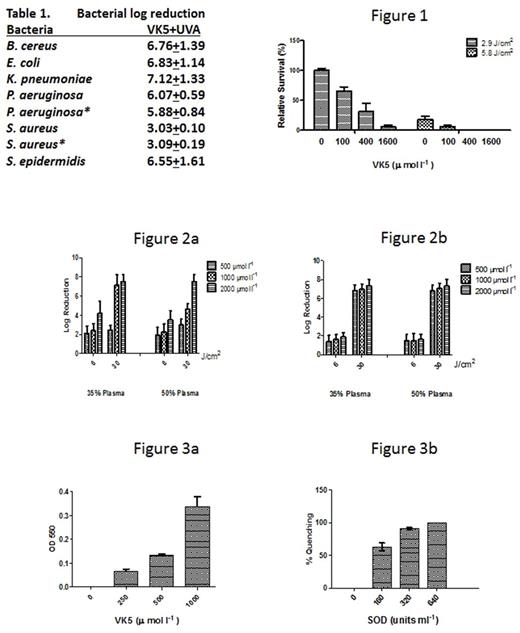Abstract
Photodynamic inactivation of bacteria has been proven as an effective method to inactivate pathogenic bacteria. This study identified vitamin K5 (VK5) as an efficient photosensitizer for ultraviolet light A (UVA) induced bacterial inactivation.
Six species of bacteria, including Bacillus cereus (vegetative form), Escherichia coli , Pseudomonas aeruginosa, Staphylococcus aureus , Staphylococcus epidermidis , Klebsiella pneumoniae , and two species of antibiotic-resistant bacteria, Pseudomonas aeruginosa and Staphylococcus aureus, were grown and mixed with VK5 and irradiated with UVA in phosphate buffered saline (PBS) in 6-well plates following our previous procedures (Xu & Vostal, 2014). A representative figure of bacterial reduction of VK5 and UVA irradiation treated E. coli , as determined by a colony forming unit (CFU) count, is shown in Figure 1. Increasing concentrations of VK5 from 0 to 1600 µmol l-1 with fixed UVA irradiation doses produce a concentration-depended reduction of bacteria. Similarly, a UVA dose response for bacterial reduction is evident with fixed VK5 concentrations. As shown in Table 1, UVA irradiation (5.8 J cm-2) with vitamin K5 (1600 µmol l-1) reduced the CFU of bacteria by three to seven logs. Antibiotic resistant bacteria ( Pseudomonas A. and Staphylococcus A ) did not exhibit resistance to the bactericidal effects of UVA and vitamin K5 combination treatment.
Efficacy of VK5 and UVA for bacterial reduction was also evident in plasma although higher concentrations of VK5 and UVA doses were required. VK5 (500 or 2000 µ mol l-1 ) in 35% or 50% bacteria spiked plasma diluted with Platelet Additive Solutions was exposed to UVA irradiation at 6 and 30 J cm-2. This treatment reduced Escherichia coli and Staphylococcus aureus CFU by up to seven logs as shown in Figures 2a and 2b, respectively.
Reactive oxygen species, hydroxyl radicals (˙OH) and superoxide anion radicals (O2˙−), were found generated in vitamin K5 aqueous solution after UVA irradiation, suggesting these oxygen species may mediate the inactivation of the bacteria. The O2˙−was generated in UVA-irradiated-VK5 PBS solution. At a fixed UVA dose of 2.9 J cm-2, the generation of O2˙− coincided with an increase in VK5 concentration from 0 to 1000 µ mol l-1 (Figure 3a). The generation of O2˙− was further confirmed by carrying out quenching study with superoxide dismutase (SOD) as specific quenchers. The production of O2˙− was reduced as the SOD concentration was increased from 0 to 640 units ml-1 in a 500 µ mol l-1 VK5 solution irradiated with a UVA ( 2.9 J cm-2 ) (Figure 3b). VK5 and UVA light combination also caused the release of ˙OH as the VK5 concentrations increased from 0 to 1000 µ mol l-1 with a fixed UVA dose of 2.9 J cm-2 The generation of ˙OH was further confirmed by mannitol, a specific quencher for ˙OH. Less ˙OH was produced when mannitol concentration was increased from 0 to 1 mol l-1, in the presence of a fixed VK5 concentration of 500 µ mol l-1 and a UVA dose of 2.9 J cm-2.
Vitamin K5 and UVA light treatment is an effective method for reduction of bacteria in solutions including plasma and may be an effective way to reduce transfusion transmitted septic reactions from contaminated plasma products.
No relevant conflicts of interest to declare.
Author notes
Asterisk with author names denotes non-ASH members.


